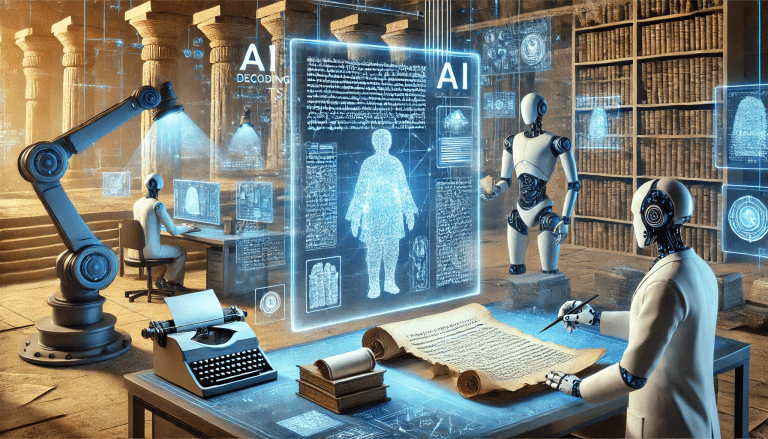
The past is often shrouded in mystery, with countless stories and knowledge lost to time. But thanks to artificial intelligence (AI), researchers are now unlocking ancient texts that were once considered unreadable. From deciphering charred Roman scrolls to interpreting crumbling cuneiform tablets, AI is revolutionizing the study of history, offering scholars more data than they’ve had in centuries.
This transformative journey began in earnest in October 2023, when Federica Nicolardi, a papyrologist at the University of Naples, received an email that would change her field forever. The message contained an image of a fragment from a papyrus scroll scorched in the eruption of Mount Vesuvius in AD 79. The scroll, part of a collection discovered in the ruins of a Roman villa in Herculaneum, had been carbonized and deemed unopenable for centuries. Yet, through the power of AI, the image revealed clear, legible Greek text.
“It was incredible,” Nicolardi recalls. “I thought, ‘So this is really happening.’” This breakthrough, part of the Vesuvius Challenge, is just one example of how AI is reshaping our understanding of the ancient world.
The AI Revolution in Ancient Text Studies
AI, particularly neural networks, is proving to be a game-changer for historians and archaeologists. These technologies are not only deciphering texts but also filling in gaps, reconstructing lost languages, and analyzing vast archives that would take humans lifetimes to process.
One of the most exciting applications of AI is its ability to reconstruct damaged or incomplete texts. For instance, convolutional neural networks (CNNs) have been used to restore eroded characters in China’s Oracle Bone Script, while recurrent neural networks (RNNs) have filled in missing words in Babylonian administrative texts. These tools are not just speeding up tedious tasks—they’re enabling researchers to ask new questions and uncover connections that were previously impossible.
The Vesuvius Challenge: Reading the Unreadable
The Vesuvius Challenge is a prime example of AI’s potential. The project, led by computer scientist Brent Seales at the University of Kentucky, aims to read the Herculaneum scrolls without physically unrolling them. Using high-resolution CT scans and AI, researchers have developed a technique called “virtual unwrapping” to map the scrolls’ internal structures and detect ink invisible to the naked eye.
In February 2024, a team of computer science students won the challenge’s grand prize by using a TimeSformer model to reveal 16 columns of Greek text from a previously unreadable scroll. The text, identified as a work of Greek philosophy on music and pleasure, is believed to be by the Epicurean philosopher Philodemus. This discovery marks a turning point in papyrology, offering a glimpse into a library that has been sealed for nearly 2,000 years.
Beyond Herculaneum: A Global Effort
The impact of AI extends far beyond Herculaneum. In South Korea, researchers are using transformer-based models to translate the vast archives of the Joseon dynasty, written in the ancient Hanja script. Meanwhile, in Greece, AI is helping to decipher Linear B tablets from Knossos, with hopes of eventually cracking the undeciphered Linear A script.
In the Middle East, the Fragmentarium project is digitizing tens of thousands of cuneiform tablets, using AI to identify overlapping fragments and uncover new lines of ancient texts, such as the Epic of Gilgamesh. Enrique Jiménez, a specialist in ancient Near Eastern literature, describes the potential of these efforts as “spectacular,” with the ability to exponentially increase the number of available sources.
A Flood of New Data
The sheer volume of data being unlocked by AI is both exciting and daunting. For papyrologists like Nicolardi, the challenge lies in processing and interpreting the flood of new texts. “We will have 400 columns of Greek text to read,” she says, emphasizing the need for collaboration and resources to keep up with the pace of discovery.
Richard Ovenden, head of the Bodleian Libraries at the University of Oxford, sees AI as a tool that enhances, rather than replaces, human expertise. “What AI is doing is giving the papyrologists data to work on which they could not otherwise have,” he says. “It’s making their work more important than it has ever been.”
Asking New Questions
As AI continues to unlock ancient texts, it’s not just about individual discoveries—it’s about reshaping how we understand history. By analyzing vast archives, researchers can identify broader trends and connections, from political shifts in ancient Korea to the evolution of writing systems across civilizations.
In the future, generative AI tools could even engage in dialogue about historical sources, offering new insights and generating hypotheses. Imagine asking a chatbot trained on thousands of ancient texts what an ancient Greek philosopher thought about music or how a Babylonian king ruled his empire.
The Future of Ancient History
The potential of AI to rewrite history is immense. As more texts are digitized and analyzed, we stand on the brink of a new era in historical research—one where the past is not just preserved but brought to life in unprecedented detail.
As Nicolardi puts it, “It’s not only about the text, it’s about the culture in general.” With AI as our guide, we are unlocking the secrets of the ancient world and rewriting history one scroll, one tablet, and one character at a time.
References:
- Jo Marchant, “How AI is unlocking ancient texts — and could rewrite history,” Nature (2025). https://www.nature.com/articles/d41586-024-04161-z
Discover more from Pasindu Lakshan Perera
Subscribe to get the latest posts sent to your email.




